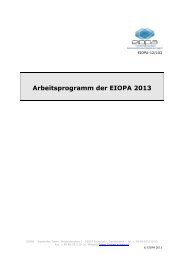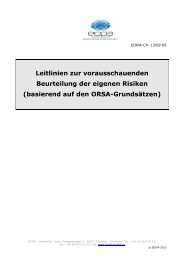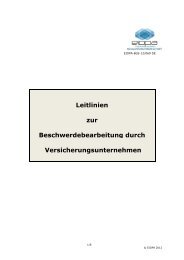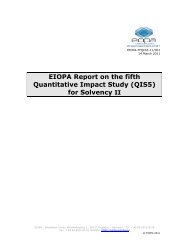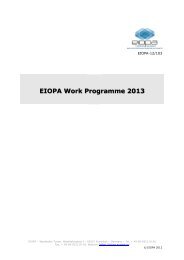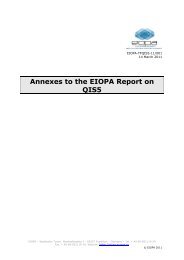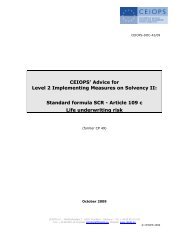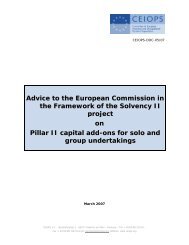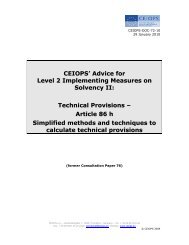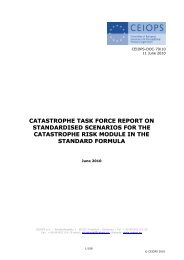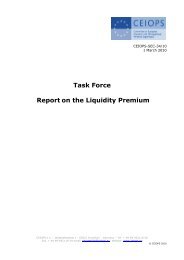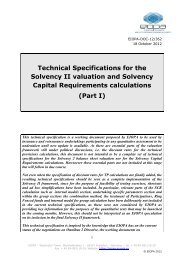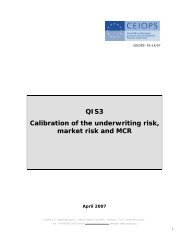Answers to the European Commission on the ... - Eiopa - Europa
Answers to the European Commission on the ... - Eiopa - Europa
Answers to the European Commission on the ... - Eiopa - Europa
Create successful ePaper yourself
Turn your PDF publications into a flip-book with our unique Google optimized e-Paper software.
features. 81 TailVaR is an example of a coherent risk measure. 82 One<br />
desirable feature is 'subadditivity', which means <str<strong>on</strong>g>the</str<strong>on</strong>g> aggregati<strong>on</strong> of<br />
risks does not lead <str<strong>on</strong>g>to</str<strong>on</strong>g> an increase in overall risk. 83 VaR, by c<strong>on</strong>trast,<br />
does not enjoy this property, except in <str<strong>on</strong>g>the</str<strong>on</strong>g> case of normally-distributed<br />
risks.<br />
10.8 For <str<strong>on</strong>g>the</str<strong>on</strong>g>se reas<strong>on</strong>s, TailVaR is <str<strong>on</strong>g>the</str<strong>on</strong>g> risk measure that <str<strong>on</strong>g>the</str<strong>on</strong>g> IAA Insurer<br />
Solvency Assessment Working Party 84 has suggested <str<strong>on</strong>g>to</str<strong>on</strong>g> use for <str<strong>on</strong>g>the</str<strong>on</strong>g><br />
purpose of setting solvency requirements.<br />
10.9 While <str<strong>on</strong>g>the</str<strong>on</strong>g> standard formula would be calibrated <str<strong>on</strong>g>to</str<strong>on</strong>g> simulate <str<strong>on</strong>g>the</str<strong>on</strong>g> effects<br />
of a particular risk measure, undertakings operating under this<br />
approach would not be expected <str<strong>on</strong>g>to</str<strong>on</strong>g> perform a VaR or TailVaR<br />
calculati<strong>on</strong> <str<strong>on</strong>g>the</str<strong>on</strong>g>mselves. The effects could be simulated using a prespecified,<br />
formulaic calculati<strong>on</strong>. Internal models could deliver<br />
requirements that are closer <str<strong>on</strong>g>to</str<strong>on</strong>g> an undertaking's 'true' VaR/TailVaR<br />
result.<br />
10.10 The most significant disadvantage associated with TailVaR is <str<strong>on</strong>g>the</str<strong>on</strong>g><br />
scarcity of data, which could lead <str<strong>on</strong>g>to</str<strong>on</strong>g> increased modelling error. A<br />
formula based <strong>on</strong> TailVaR might be difficult <str<strong>on</strong>g>to</str<strong>on</strong>g> generalise in such a way<br />
as <str<strong>on</strong>g>to</str<strong>on</strong>g> provide a good fit for <str<strong>on</strong>g>the</str<strong>on</strong>g> majority of insurance undertakings (i.e.<br />
<str<strong>on</strong>g>the</str<strong>on</strong>g> standard formula would over- or under-estimate capital<br />
requirements in many cases because it would be calibrated using tail<br />
data that may not be representative).<br />
10.11 Following changes <str<strong>on</strong>g>to</str<strong>on</strong>g> <str<strong>on</strong>g>the</str<strong>on</strong>g> Framework for C<strong>on</strong>sultati<strong>on</strong>, CEIOPS 85 notes<br />
that <str<strong>on</strong>g>the</str<strong>on</strong>g> <str<strong>on</strong>g>Commissi<strong>on</strong></str<strong>on</strong>g> Services are proposing <str<strong>on</strong>g>the</str<strong>on</strong>g> use of VaR as a<br />
general principle for calculating <str<strong>on</strong>g>the</str<strong>on</strong>g> SCR. For internal models, <str<strong>on</strong>g>the</str<strong>on</strong>g><br />
<str<strong>on</strong>g>Commissi<strong>on</strong></str<strong>on</strong>g> Services acknowledge in CfA 11 that more advanced<br />
modelling techniques could be used, including <str<strong>on</strong>g>the</str<strong>on</strong>g> use of TailVaR as a<br />
risk measure. CEIOPS would stress <str<strong>on</strong>g>the</str<strong>on</strong>g> importance of a comm<strong>on</strong><br />
underlying philosophy for <str<strong>on</strong>g>the</str<strong>on</strong>g> SCR, applicable <str<strong>on</strong>g>to</str<strong>on</strong>g> both <str<strong>on</strong>g>the</str<strong>on</strong>g> standard<br />
formula and internal models. Using different risk measures would<br />
impact <str<strong>on</strong>g>the</str<strong>on</strong>g> incentives <str<strong>on</strong>g>to</str<strong>on</strong>g> move from <str<strong>on</strong>g>the</str<strong>on</strong>g> standard formula <str<strong>on</strong>g>to</str<strong>on</strong>g> internal<br />
models and would lead <str<strong>on</strong>g>to</str<strong>on</strong>g> unpredictable results in <str<strong>on</strong>g>the</str<strong>on</strong>g> c<strong>on</strong>text of partial<br />
models. Since internal models strive for a more accurate mapping of<br />
<str<strong>on</strong>g>the</str<strong>on</strong>g> business and <str<strong>on</strong>g>the</str<strong>on</strong>g>refore are more likely <str<strong>on</strong>g>to</str<strong>on</strong>g> address also <str<strong>on</strong>g>the</str<strong>on</strong>g><br />
c<strong>on</strong>sequences of tail events, <str<strong>on</strong>g>the</str<strong>on</strong>g> use of TailVaR would smooth <str<strong>on</strong>g>the</str<strong>on</strong>g><br />
transiti<strong>on</strong> from <str<strong>on</strong>g>the</str<strong>on</strong>g> standard formula <str<strong>on</strong>g>to</str<strong>on</strong>g> internal models and facilitate<br />
partial use.<br />
81 Artzner, Ph. et al, 'Coherent Measures of Risk' (1999) – Ma<str<strong>on</strong>g>the</str<strong>on</strong>g>matical Finance 9.<br />
82 Internati<strong>on</strong>al Actuarial Associati<strong>on</strong> (2004) – A Global Framework of Insurer Solvency Assessment.<br />
83<br />
Subadditivity means that ρ(A + B) ≤ ρ(A) + ρ(B), where ρ is a risk measure and A, B represent any two<br />
portfolios.<br />
84 IAA (2004) – A global framework for insurer solvency assessment.<br />
85 MARKT/2506/04 (2005) – Amended Framework for C<strong>on</strong>sultati<strong>on</strong>.<br />
83



